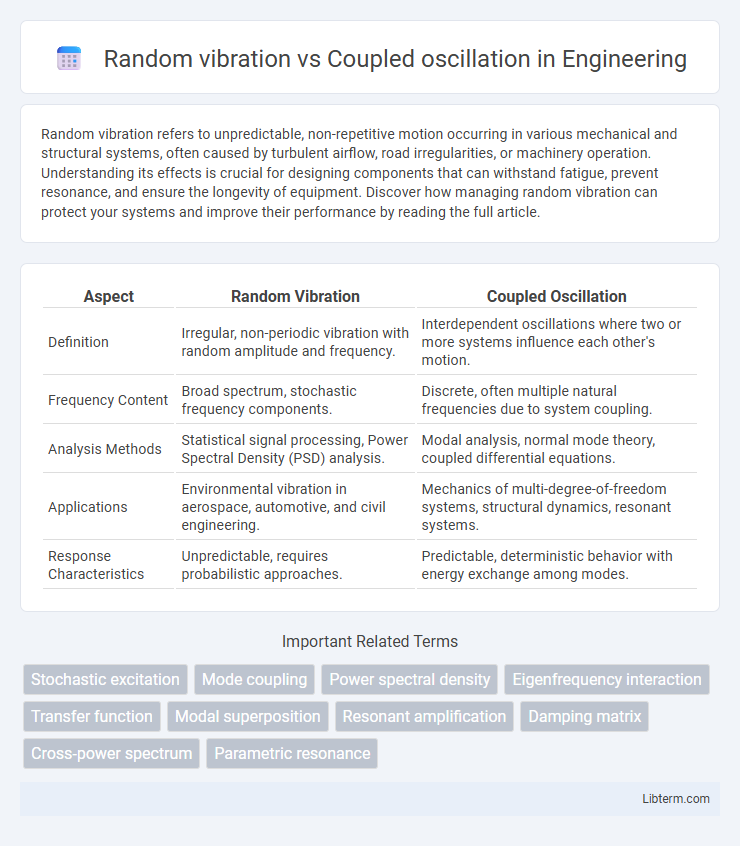Random vibration refers to unpredictable, non-repetitive motion occurring in various mechanical and structural systems, often caused by turbulent airflow, road irregularities, or machinery operation. Understanding its effects is crucial for designing components that can withstand fatigue, prevent resonance, and ensure the longevity of equipment. Discover how managing random vibration can protect your systems and improve their performance by reading the full article.
Table of Comparison
| Aspect | Random Vibration | Coupled Oscillation |
|---|---|---|
| Definition | Irregular, non-periodic vibration with random amplitude and frequency. | Interdependent oscillations where two or more systems influence each other's motion. |
| Frequency Content | Broad spectrum, stochastic frequency components. | Discrete, often multiple natural frequencies due to system coupling. |
| Analysis Methods | Statistical signal processing, Power Spectral Density (PSD) analysis. | Modal analysis, normal mode theory, coupled differential equations. |
| Applications | Environmental vibration in aerospace, automotive, and civil engineering. | Mechanics of multi-degree-of-freedom systems, structural dynamics, resonant systems. |
| Response Characteristics | Unpredictable, requires probabilistic approaches. | Predictable, deterministic behavior with energy exchange among modes. |
Introduction to Random Vibration and Coupled Oscillation
Random vibration involves unpredictable, non-periodic oscillations often caused by stochastic processes, affecting structures in environments like automotive or aerospace industries. Coupled oscillation refers to interconnected systems where individual oscillators influence one another, resulting in complex, synchronized motion patterns. Understanding these concepts is crucial for designing systems that endure variable dynamic loads and maintain stability.
Defining Random Vibration: Key Concepts
Random vibration refers to unpredictable, non-periodic oscillations characterized by stochastic processes, often modeled using power spectral density (PSD) to capture frequency content and amplitude distribution. It contrasts with coupled oscillation, where multiple oscillators interact through defined dynamic relationships leading to predictable modal behavior. Key concepts in random vibration include statistical measures such as root mean square (RMS) acceleration, probability density functions, and response spectra used to analyze system responses under random excitation.
Understanding Coupled Oscillation: Core Principles
Coupled oscillation occurs when two or more oscillators interact and influence each other's motion through a coupling mechanism, leading to energy transfer between them and synchronized or complex vibration modes. Understanding core principles involves analyzing the system's normal modes, where the oscillators move in fixed patterns with characteristic frequencies determined by coupling strength and system parameters. Unlike random vibration, which is stochastic and lacks determinism, coupled oscillation displays predictable, frequency-dependent behavior critical in mechanical systems, electronics, and structural dynamics.
Sources and Applications of Random Vibration
Random vibration originates from unpredictable and non-periodic environmental forces such as turbulent airflow, road surface irregularities, and seismic activity, impacting structures and mechanical systems. Applications include aerospace component testing, vehicle suspension system analysis, and earthquake engineering to ensure durability and performance under stochastic loading. These random forces contrast with coupled oscillations, which stem from interactions of interconnected oscillators resulting in predictable, periodic motion patterns.
Real-World Examples of Coupled Oscillation
Coupled oscillation occurs when two or more oscillators interact, causing energy transfer and synchronized motion, as seen in pendulum clocks mounted on a shared beam that eventually swing in unison. This phenomenon also appears in bridge engineering, where synchronized oscillations between different segments can lead to resonance-induced failures like the Tacoma Narrows Bridge collapse. Coupled oscillations are critical in understanding natural systems such as heart cells, which beat in coordinated patterns essential for effective blood circulation.
Mathematical Modeling: Random vs. Coupled Systems
Random vibration modeling involves stochastic processes characterized by spectral density functions and probabilistic time histories, requiring statistical methods like power spectral density analysis and Monte Carlo simulations to predict system response. Coupled oscillation systems are described by deterministic differential equations with multiple degrees of freedom, typically modeled using matrix methods such as eigenvalue analysis and modal decomposition to solve for natural frequencies and mode shapes. Mathematical treatment of random vibrations emphasizes probabilistic response estimation, whereas coupled oscillatory systems rely on solving coupled linear or nonlinear ordinary differential equations for dynamic behavior prediction.
Analysis Techniques for Vibrational Systems
Random vibration analysis employs statistical methods such as power spectral density (PSD) and Monte Carlo simulations to characterize the unpredictable, stochastic nature of vibrational inputs, enabling engineers to predict system responses under real-world dynamic conditions. Coupled oscillation analysis relies on solving coupled differential equations using matrix methods like modal analysis and state-space techniques to understand the interaction between multiple degrees of freedom in interconnected systems. Advanced simulation tools integrate both approaches to optimize design robustness by addressing both random environmental excitations and deterministic coupled system dynamics.
Impact on Structural Dynamics and Stability
Random vibration induces unpredictable, broadband frequency excitations that can cause fluctuating stresses and fatigue in structures, challenging traditional design assumptions and requiring advanced probabilistic analysis for stability assessment. Coupled oscillation involves interactions between multiple modes, leading to resonance phenomena that amplify dynamic responses and potentially destabilize systems through mode coupling. Understanding these mechanisms is critical for accurately predicting structural behavior, optimizing damping strategies, and ensuring long-term durability in complex engineering systems.
Advantages and Limitations of Each Approach
Random vibration analysis captures real-world, unpredictable forces affecting structures, providing crucial insights for durability and fatigue assessment, but requires extensive computational resources and complex statistical modeling. Coupled oscillation models simplify system interactions by analyzing interdependent oscillations, offering efficient simulations and clear mode relationships, yet may overlook stochastic environmental influences and nonlinearities. Selecting between these approaches depends on balancing accuracy in representing random excitations against modeling simplicity and computational feasibility.
Summary: Choosing Between Random Vibration and Coupled Oscillation
Random vibration describes unpredictable, non-periodic motion caused by stochastic forces, commonly analyzed in structural dynamics and aerospace engineering to assess fatigue and failure risks. Coupled oscillation involves interacting oscillatory systems where energy exchange leads to fixed frequency patterns, important in mechanical systems and molecular dynamics. Selecting between random vibration and coupled oscillation depends on system behavior analysis: unpredictable, broadband frequency responses require random vibration models, while deterministic, frequency-locked interactions necessitate coupled oscillation frameworks.
Random vibration Infographic

 libterm.com
libterm.com